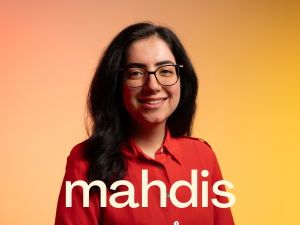‟ A career in science demands years of dedication. For more women to pursue it as a career path, it needs to be financially exciting and socially rewarding.”
This is Mahdis Jalali’s story. From watching her dad celebrate research milestones as a university professor, she always knew an academic career was in her future. Today, this detail-oriented engineer brings her problem-solving spirit to Luxembourg, developing smarter satellite communication systems. Inspired by mathematician Maryam Mirzakhani, Mahdis navigates the male-dominated tech world with determination, ensuring satellites “send lights to Earth safely”—as she would charmingly explain to children.
What is your background and what brought you to Luxembourg?
I did my bachelor’s in electrical engineering at Amirkabir University of Technology in Tehran. Then I did my master’s at the same university in wireless telecommunication. Basically, sending and receiving signals without wires—how you can send signals, receive them, and make them understandable for people or devices. Currently, I’m working on satellite communication. I came to Luxembourg in September 2021 to join SnT for my PhD studies. I wanted to do my PhD abroad, and I was interested in the research topics of the Sigcom group specifically. When I saw the position they had, I knew I had to apply!
Did you always know you wanted to pursue this career path?
I think my teenage-self wouldn’t be all that surprised to see me pursuing a PhD. I was quite interested in maths, physics, electronics, and electrical engineering, as a teenager. The satellite bit actually came later—I got interested in wireless communication during my studies. Funnily enough, the satellite direction happened almost by accident during my master’s—someone suggested it to me, I gave it a go, and I loved it!
Could you explain your current research in simple terms?
I’m working on interference management between different types of satellite systems. There are these geostationary satellites that stay fixed above one spot on Earth, and then there are constellations of non-geostationary satellites in lower orbits that move across the sky. When these satellites beam down signals, they can mess with the first satellites’ receivers. I’m developing smarter ways to keep them from interfering with each other while making sure everyone stays connected.
‟ To explain it to a child: We have different satellites sending lights to Earth. I want to make sure these lights don’t hit each other, so they get to Earth safely.”
How does your research work translate to your daily life?
The problem-solving mindset definitely spills over into my everyday life— finding optimal solutions is both a blessing and a curse! You get really good at tackling problems, looking at them from all angles, and finding different ways forward. The downside? I tend to get bogged down in details and try to optimise absolutely everything, which isn’t always possible in real life. But honestly, being able to see challenges from different perspectives has been incredibly helpful overal.
Who inspired your interest in science and research?
My father is a professor at university back in Iran. Growing up, research was just part of our family life—I’d see him working on papers and then we’d all celebrate together for his achievements, like when he was in the top one percent scientists. It made science feel like a natural path to follow. He was definitely my first role model. I was also inspired by Maryam Mirzakhani, a brilliant Iranian mathematician who became the first woman ever to win the Fields Medal. I think every girl in Iran is really inspired by her work. To see someone from your country reach those heights globally—it’s just incredibly powerful.
What has been your own experience as a woman in this research field?
It’s male-dominated and pretty much set up that way from the ground up. After my master’s, I worked at this telecommunications space research centre where I was one of just two women engineers. I realised I had to adjust to not be overlooked—to act or imitate what male colleagues did.
How can we encourage more girls to pursue careers in science and research?
I think it needs to start in schools—making science, math, and physics more engaging and fun for girls. During those teenage years, we’ve got to show them that science research isn’t just interesting, but offers a proper career path too. Governments also need to step up and ensure researchers can earn a decent living.
If you could sum up what tech research needs in one phrase, what would it be?
Purposeful investment.
Supported by the Luxembourg National Research Fund.
